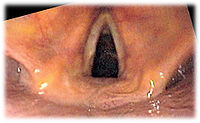
Photo from wikipedia
Abstract Various videolaryngoscopes (VLs) have been developed to provide a better laryngeal view and facilitate difficult intubations. The goal of this study was to compare 2 VLs, the Pentax AWS… Click to show full abstract
Abstract Various videolaryngoscopes (VLs) have been developed to provide a better laryngeal view and facilitate difficult intubations. The goal of this study was to compare 2 VLs, the Pentax AWS and the McGrath VL, with respect to intubation time and ease of intubation. One hundred forty patients aged 19 to 65 years (American Society of Anesthesiologists classification I or II), who required tracheal intubation for elective surgery, were randomly assigned to 1 of the 2 groups: the Pentax AWS (n = 70) or the McGrath VL (n = 70). The primary outcome was time to intubation (TTI) measured by a blind observer. The intubation difficulty scale (IDS), percentage of glottic opening (POGO) scale, glottic grade, use of optimal external laryngeal manipulation (OELM), and ease of intubation were also recorded. The Pentax AWS provided a better laryngeal view than the McGrath VL with respect to the Cormack-Lehane (CL) glottic grade (1/2a/2b) (63/7/0 vs 43/24/3, P < .001) and the POGO scale (median [interquartile range, IQR]) (100 [100–100] vs 100 [80–100], P < .001). The IDS was significantly lower in the Pentax AWS group compared with the McGrath VL group (median [IQR]) (0 [0–0] vs 0 [0–1], P < .001). However, the TTI was similar in both the Pentax AWS and McGrath VL groups (median [IQR]) (30 [27–34] vs 32 [27–35] seconds, P = .440). OELM and ease of intubation were also similar between the 2 groups. The Pentax AWS offered a superior laryngeal view compared with the McGrath VL. There was no significant difference in either the intubation time or ease of intubation using these 2 devices in patients with normal airways.
Journal Title: Medicine
Year Published: 2017
Link to full text (if available)
Share on Social Media: Sign Up to like & get
recommendations!